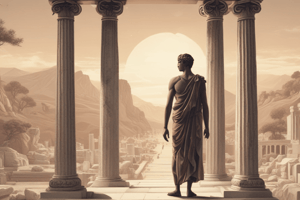Podcast
Questions and Answers
What time period does Archaic Art refer to?
What time period does Archaic Art refer to?
- 480 - 400 BC
- 323 - 30 BC
- 600 - 480 BC (correct)
- 400 - 323 BC
Which period does Classical Art belong to?
Which period does Classical Art belong to?
- 480 - 400 BC (correct)
- 323 - 30 BC
- 400 - 323 BC
- 600 - 480 BC
What does Late Classical Art refer to?
What does Late Classical Art refer to?
- 323 - 30 BC
- 600 - 480 BC
- 400 - 323 BC (correct)
- 480 - 400 BC
What time frame does Hellenistic Art cover?
What time frame does Hellenistic Art cover?
What is one innovation in Greek sculpture?
What is one innovation in Greek sculpture?
What characterizes Greek Classical Sculpture?
What characterizes Greek Classical Sculpture?
Describe one characteristic of Greek Hellenistic Sculpture.
Describe one characteristic of Greek Hellenistic Sculpture.
What was the main purpose of Greek architecture?
What was the main purpose of Greek architecture?
What style emphasizes large figures drawn in black on red clay?
What style emphasizes large figures drawn in black on red clay?
Which type of pottery was used for mixing water and wine?
Which type of pottery was used for mixing water and wine?
Flashcards are hidden until you start studying
Study Notes
Greek Art Periods
- Archaic Art: 600 - 480 BC, characterized by stiff figures and the early development of sculpture.
- Classical Art: 480 - 400 BC, noted for idealized human forms and the introduction of contrapposto.
- Late Classical Art: 400 - 323 BC, emphasized humanization of gods and elongated body forms.
- Hellenistic Art: 323 - 30 BC, known for dramatic expression, increased realism, and complex themes.
Innovations of Greek Sculpture
- Greek artists embraced nudity, celebrating the human body distinctly from earlier cultures.
- Large-scale marble sculptures often featured negative space, enhancing their visual impact.
- Usage of contrapposto became prominent, giving sculptures a more natural stance.
Characteristics of Greek Archaic Sculpture
- Typically crafted from marble, featuring figures with smiles to convey life.
- Often painted, showcasing attention to color and detail.
- Kouros and Kore figures presented in upright, formal poses with detailed hair.
Characteristics of Greek Classical Sculpture
- Transition to contrapposto allowed for more lifelike and dynamic postures.
- Bodies were highly idealized, establishing a canon influenced by artist Polykleitos.
- Late Classical sculptures depicted gods in more relatable forms with S-shaped curves.
Characteristics of Greek Hellenistic Sculpture
- Focused on realism, capturing movement and emotional expressions.
- Greater negative space enabled multidimensional viewing experiences.
- Explored diverse themes such as childhood, old age, and emotional states like despair and anger.
Innovations in Greek Architecture
- Temples designed as earthly homes for gods, highlighting architectural significance.
- Three styles of temples: Doric (simplistic, unadorned), Ionic (spiral capitals, decorative friezes), and Corinthian (leaf capitals).
- The Parthenon exemplifies a blend of architectural styles and introduced Caryatids as columns.
Characteristics of Greek Architecture
- Temples were rectangular and adhered to strict geometric principles.
- Pediments above columns depicted sculptural narratives of gods' deeds.
- Temples primarily served as deities' dwelling places; few people entered them.
Innovations of Greek Pottery
- Functional designs tailored for specific uses, highlighting practicality.
- Amphora for storage, krater for mixing drinks, and kylix for casual drinking.
Characteristics of Greek Pottery
- Early black-figure painting emphasized large black figures on red clay.
- Transition to red-figure painting allowed for more detailed and fluid representations.
- Evolution from stiff Archaic styles to dynamic poses in Classical and Hellenistic periods.
Studying That Suits You
Use AI to generate personalized quizzes and flashcards to suit your learning preferences.




